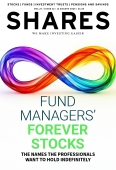Archived article
Please note that tax, investment, pension and ISA rules can change and the information and any views contained in this article may now be inaccurate.
Twenty-five years after the first one launched in the UK how have ETFs changed?

This year marks the 25th anniversary of the first ETF (exchange traded fund) launched on the London Stock Exchange. The ETF market has grown rapidly in the quarter of a century since the first such product ̶ iShares Core FTSE 100 UCITS (ISF) ̶ was listed in April 2000.
Now the UK markets hosts more than 2,350 ETPs (exchange-traded products) with more than £1 trillion in AUM (assets under management). In 2024 270 ETPs joined the London Stock Exchange.
Jane Sloan, Europe Middle East Africa head of shares and global product solutions at BlackRock observes: ‘ETP trading now makes up 20% of the London Stock Exchange’s daily trading turnover, with trading spread across 19 market makers.
‘Advances in technology, particularly the rise of ETF algorithms for trading, could lead to the creation of even more sophisticated ETF products and trading strategies.
‘In April 2025, we also recorded our highest trading day in ETPs, with £2.6 billion traded on the LSE order book,’ Sloan adds.
KEY FEATURES OF ETFS
Diversification. An ETF can include hundreds of securities thus reducing risk through diversification.
Liquidity. ETFs can be bought and sold through the trading day just like stocks. Funds are typically priced once a day at a level investors usually only find out after they have submitted their trade.
Low fees. Most ETFs have lower ongoing charges compared to funds.
WHAT ARE ETFS?
An ETF tracks a basket of assets consisting of stocks, bonds and commodities that you can buy and sell through a broker or investment platform.
Most ETFs are passive and aim to replicate the performance of a specific index, benchmark or sector rather than beat it.
ETFS TRACKING THE DEFENCE BOOM
The recent ‘boom’ in defence ETFs is difficult for investors to ignore. According to quarterly data from Ark Invest Europe (as of 6 May) defence ETFs accounted for 72% of European thematic net flows for the first quarter of this year – amounting to $4.18 billion.
Ark Invest cites ‘the demand for next-gen military and aerospace technology’ and ‘defence-tech firms benefiting from increased procurement budgets globally.’
Back in June, the UK government announced its SDR (Strategic Defence Review) aimed at moving the UK to a position of ‘war fighting readiness,' the UK government has already committed to increase military spending to 2.5% of GDP (gross domestic product) by 2028, on the 1 June this will be increased to 3% during the next parliamentary term (2029-2034).
This enthusiasm has led to several ETF providers launching defence-related ETFs.
In May, Global X ETFs Europe launched the Global X Europe Focused Defence Tech UCITS ETF (EDEF).
In March ETF provider WisdomTree launched its WisdomTree Europe Defence ETF (WDEF), as of 27 June, AUM surpassed $3 billion, as investors keen to gain exposure to Europe’s long-term defence transformation piled into the ETF.
Adrià Beso, head of distribution, Europe at WisdomTree, said: ‘The NATO (North Atlantic Treaty Organisation) summit has made it clearer than ever: European countries are stepping up their defence commitments, with increased spending now a top priority.
‘For investors, this marks the next phase of a long-term shift. As governments channel more funds into the defence space, we see strong potential for sustained growth across the sector. Companies that support modern military capabilities and critical infrastructure are well-positioned to benefit, making European defence an increasingly important area for capital allocation.’
HOW HAVE ETFS CHANGED?
The ETFs sector has evolved over the past 25 years and one big development is the emergence of thematic products – enabling investors to tap into emerging trends.
Mobeen Tahir, director of macroeconomics and thematic research at WisdomTree tells Shares that thematic investing has gained significant momentum over the past decade: ‘For Europe-domiciled ETFs and open-ended funds combined, thematic AUM have grown from around $71 billion 10 years ago to $593 billion as of the end of June.
‘We group the thematic universe into four broad categories: demographic and social shifts, environmental pressures, geopolitical forces, and technological advancements. Based on AUM, the two largest clusters are technology and environmental themes, reflecting investor focus on innovation and sustainability.
‘More recently, the geopolitical category has gained ground, particularly within ETFs. Rising global tensions have driven strong interest in defence. In the first half, the “rise of tension” theme – a subset of our geopolitical category that includes defence – has seen around $8.3 billion in net inflows.’
THE RISE OF ACTIVE ETFS
In the last few years active ETFs have started to become a bigger component of the ETF universe. According to State Street’s ETF Impact Report 2025-2026 active ETFs secured $166 billion in global inflows in 2023, and $330.7 billion in 2024 – 22.2% of all ETF inflows globally.
Year-to-date tells a similar story, with this category of product pulling in $94.3 billion and representing 32% of all ETF flows in 2025.
Multiple factors are behind the inflows, including increased product innovation, the continued migration of assets from funds to an ETF wrapper, and international investor demand.
Robert Selouan, senior research strategist at State Street says in the report: ‘Since the global financial crisis and the 2020 pandemic sell-off, investors are looking for more stability and protection from those kinds of events, especially as they near retirement.
‘Active ETFs have started to answer that call, as they’ve evolved beyond their traditional role of benchmark outperformance or alpha.
‘Increasingly, they’re now being used to target specific outcomes or improve portfolio risk management - and potentially provide more predictable risk/reward trade-offs, better downside protection, and greater risk-adjusted returns.’
However, for now active ETFs are less numerous, prominent and popular in the UK and Europe. That may change but it is worth remembering in this context that UK investors are unable to trade US-listed ETFs.
WHICH ETFS HAVE PERFORMED WELL RECENTLY?
According to data firm Morningstar, the best performing UK ETF in the second quarter of this year was the £389 million VanEck Crypto & Blockchain innovators UCITS ETF (DAPP) which returned 71.4%.
The second and third best performing ETFs have been from the uranium and nuclear technologies sector. Both passively managed.
The £205 million Global X Uranium UCITS ETF (URNU) returned 62.5% and the £575 million VanEck Uranium and Nuclear Technologies UCITS ETF (NUCL) returned 56.4% to investors.
Other ETFs that have performed well include the actively managed Ark Innovation UCITS ETF (ARKK) which returning 39% in the second quarter. The product launched in April 2024 and invests in disruptive technologies.
WHAT NEXT FOR ETFS?
WisdomTree’s Tahir sees five key themes gaining prominence for ETF investors in the future including: European defence autonomy, nuclear energy, cybersecurity, critical minerals and blockchain infrastructure.
Tahir says in relation to the theme blockchain infrastructure: ‘Financial fragmentation is accelerating blockchain adoption. From tokenisation to stablecoins, digital finance is becoming a tool of strategic competition.’
Important information:
These articles are provided by Shares magazine which is published by AJ Bell Media, a part of AJ Bell. Shares is not written by AJ Bell.
Shares is provided for your general information and use and is not a personal recommendation to invest. It is not intended to be relied upon by you in making or not making any investment decisions. The investments referred to in these articles will not be suitable for all investors. If in doubt please seek appropriate independent financial advice.
Investors acting on the information in these articles do so at their own risk and AJ Bell Media and its staff do not accept liability for losses suffered by investors as a result of their investment decisions.
Issue contents
Exchange-Traded Funds
Feature
Great Ideas
News
- Eli Lilly shares under pressure after disappointing clinical trial results
- Recruiter Hays set to update expectations with shares at decade-low
- Record numbers of US companies are beating revenue and earnings forecasts
- Fresnillo up 180% year-to-date after latest strong results
- All eyes on second-quarter retail bellwether Walmart
- Bellway brings a ray of light to the housebuilders with its half-year update
 magazine
magazine








